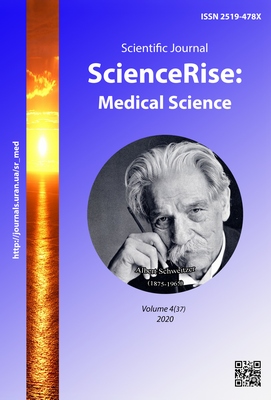Analysis of blood gas composition indicators in premature babies with neonatal sepsis
DOI:
https://doi.org/10.15587/2519-4798.2020.209147Keywords:
neonatal sepsis, premature infants, oxygen status indicators, respiratory indexAbstract
The aim of the study was analysis of oxygen status of patients with neonatal sepsis during monitoring of premature infants.
Materials and methods. Indicators of oxygen status of capillary blood were assessed in premature infants with neonatal sepsis who were treated at the Regional Perinatal Center in Khmelnytsky during 2017–2018. The study included mostly deeply premature babies, including those with extremely low weight. A full range of clinical and laboratory studies, including determination of oxygen status of capillary blood.
Research results. Our results allow us to conclude that while such indicators as pH, pO2, BEb3, % SO2 do not change significantly, the trouble can be detected using indicators such as AdDO2, RI, PI, which reflect the state of oxygenation with impaired ventilation. -perfusion ratios, increased blood shunting and the processes of delivery and consumption of oxygen at the tissue level. The calculated indicator "PIP×FiO2" was less sensitive to assess changes in the lungs and did not correspond to the clinical picture of the severity of the patient's condition.
Conclusion. Thus, the determination of AdDO2, RI, PI capillary blood can be used as informative indicators for determining the oxygen status in premature infants, which is of significant practical importance in terms of limited monitoring of the gas composition of arterial blood
References
- Parshin, Y. V., Aleksandrovich, Y. S., Kushnerik, L. A., Blinov, S. A., Pshenisnov, K. V., Nurmagambetova, B. K. (2010). Oxygen Status Parameters as Markers of Renal Dysfunction in Neonatal Infants with Critical Status. General Reanimatology, 6 (2), 62–67. doi: http://doi.org/10.15360/1813-9779-2010-2-62
- Arayici, S., Şimşek, G. K., Canpolat, F. E., Oncel, M. Y., Uras, N., Oguz, S. S. (2019). Can Base Excess be Used for Prediction to Early Diagnosis of Neonatal Sepsis in Preterm Newborns? Mediterranean journal of hematology and infectious diseases,11 (1), e2019014. doi: http://doi.org/10.4084/mjhid.2019.014
- Kassie, D. G., Tewolde, A. W. S., Bogale, W. A. (2020). Premature Rupture of Membrane and Birth Asphyxia Increased Risk of Neonatal Sepsis Among Neonates in the Neonatal Intensive Care Unit at the University of Gondar Specialized Referral Hospital, Northwest Ethiopia. The Pediatric Infectious Disease Journal, 5 (1), 1. doi: http://doi.org/10.36648/2573-0282.5.1.68
- Perestoronina, M. V. (2015). Comparison of oxygen indicators in capillary blood full term newborns and infants with extremely low birth weight. Omskii nauchnii vestnik, 2 (144), 113–115.
- Shkurupii, D. A. (2013). Zahalni tendentsii klinichnoho perebihu syndromu poliorhannoi nedostatnosti u novonarodzhenykh. Bil, Zneboliuvannia i intensyvna terapiia, 1, 46–51.
- Petrenko, Iu. V., Ivanov, D. O., Kurzina, E. A. (2011). Ocenka organnoi nedostatochnosti u novorozhdennykh. Biulleten federalnogo centra serdca, krovi i endokrinologii im. V. A. Almazova, 43–50.
- Perestoronina, M. V., Korpacheva, O. V., Palyanov, S. V., Dolgikh, V. T. (2015). The parameters of the oxygen status in the assessment of prognosis of a hemodynamically significant patent ductus arteriosus preterm neonatal infants. General Reanimatology, 11 (2), 35–41. doi: http://doi.org/10.15360/1813-9779-2015-2-35-41
- Tan, R. N. G. B., Pauws, S. C., van Loon, E., Smits, V. E. H. J., Lopriore, E., te Pas, A. B. (2018). Correlation and Interchangeability of Venous and Capillary Blood Gases in Non-Critically Ill Neonates. Frontiers in Pediatrics, 6. doi: http://doi.org/10.3389/fped.2018.00089
- Andersen, C. C., Hodyl, N. A., Kirpalani, H. M., Stark, M. J. (2017). A Theoretical and Practical Approach to Defining “Adequate Oxygenation” in the Preterm Newborn. Pediatrics, 139 (4), e20161117. doi: http://doi.org/10.1542/peds.2016-1117
- Kayton, A., Timoney, P., Vargo, L., Perez, J. A. (2018). A Review of Oxygen Physiology and Appropriate Management of Oxygen Levels in Premature Neonates. Advances in Neonatal Care, 18 (2), 98–104. doi: http://doi.org/10.1097/anc.0000000000000434
- Grizelj, R., Bojanić, K., Pritišanac, E., Luetić, T., Vuković, J., Weingarten, T. N. et. al. (2016). Survival prediction of high-risk outborn neonates with congenital diaphragmatic hernia from capillary blood gases. BMC Pediatrics, 16 (1). doi: http://doi.org/10.1186/s12887-016-0658-y
- Singer, M., Deutschman, C. S., Seymour, C. W., Shankar-Hari, M., Annane, D., Bauer, M. et. al. (2016). The Third International Consensus Definitions for Sepsis and Septic Shock (Sepsis-3). JAMA, 315 (8), 801–810. doi: http://doi.org/10.1001/jama.2016.0287
- Ruan, L., Chen, G.-Y., Liu, Z., Zhao, Y., Xu, G.-Y., Li, S.-F. et. al. (2018). The combination of procalcitonin and C-reactive protein or presepsin alone improves the accuracy of diagnosis of neonatal sepsis: a meta-analysis and systematic review. Critical Care, 22 (1). doi: http://doi.org/10.1186/s13054-018-2236-1
Downloads
Published
How to Cite
Issue
Section
License
Copyright (c) 2020 Olena Vlasova, Larysa Kolyubakina

This work is licensed under a Creative Commons Attribution 4.0 International License.
Our journal abides by the Creative Commons CC BY copyright rights and permissions for open access journals.
Authors, who are published in this journal, agree to the following conditions:
1. The authors reserve the right to authorship of the work and pass the first publication right of this work to the journal under the terms of a Creative Commons CC BY, which allows others to freely distribute the published research with the obligatory reference to the authors of the original work and the first publication of the work in this journal.
2. The authors have the right to conclude separate supplement agreements that relate to non-exclusive work distribution in the form in which it has been published by the journal (for example, to upload the work to the online storage of the journal or publish it as part of a monograph), provided that the reference to the first publication of the work in this journal is included.









